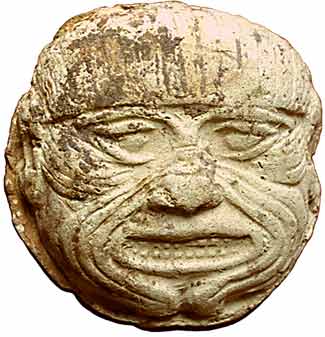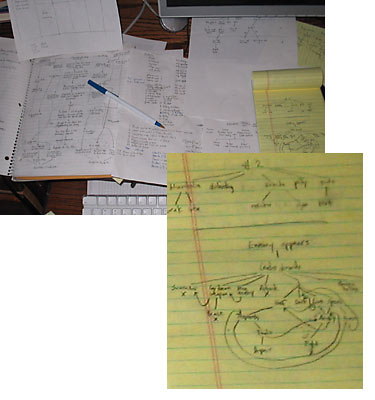
A bust of Humbaba the demon, Babylonia, circa 2000-1600 BC, when "Whom the Telling Changed" takes place. Even four thousand years ago, the legend of Gilgamesh was already shrouded in mystery and legend.
Release 2
November 2005
Like the Gilgamesh epic itself, "Whom the Telling Changed" has evolved considerably in the 15 months since I first conceived it. Originally designed to be a short experiment with a one-word parser, the piece expanded to become a much more elaborate experiment in rhetoric, NPC interaction, and interactive storytelling in general. I said in an interview shortly after the first release of the game in the 2005 Spring Thing that I considered it "not entirely a failure." Release 2 is still not a success, but I hope it is at least a more interesting failure.
 A bust of Humbaba the demon, Babylonia, circa 2000-1600 BC, when "Whom the Telling Changed" takes place. Even four thousand years ago, the legend of Gilgamesh was already shrouded in mystery and legend. |
The central concept of the piece is that a story is being told, while both the player and a rival character attempt to use the story to sway the listeners to their own point of view. The piece is highly interactive, although not in the "branching tree" method where each choice sends the story in a different direction. "Whom the Telling Changed" always has the same core beats of its beginning, middle, and end--but the player has a high degree of freedom in choosing the details of those beats, how they unfold, and most importantly, what they signify to both the characters and the player.
One of the goals was to explore an issue and allow the player to take either side and "win" with it, without the story itself passing judgement on either side as a "better" or more correct ending. While Release 2 is farther along at meeting this goal than Release 1, it's still not there. The argument in the inner story is essentially pro-war or pro-peace, and the work has been accused of favoring the pro-peace side. This is probably a legitimate opinion: the pro-war ending(s) do not feel entirely satisfying to me. Perhaps a future third release will work on this, or perhaps complete balance is a goal for a future project.
The roles of five of the six major characters in the story are flexible, shaped at least to some degree by the player's input. The player character himself, of course, can be either a warrior or a healer, who has either pro-war or anti-war views, which may even change over the course of the game. The player character's gender is not specified--it wasn't either in my last game, Gourmet. I think one of the strengths of interactive fiction is the closeness of the bond between the player and the protagonist, which has at least the potential to be much closer than in ordinary fiction, and I like to encourage the player to identify with the protagonist. The player does pick the gender of a lover, who starts the story with similar allegiances as the player, and an enemy, who starts diametrically opposed. The storyteller can be one of two people--the choice of which has a subtle effect on how the story is told--and the other remains a kindly older relative. The final major character, the leader of the group of strangers intruding in the valley, is not shaped directly by the player, but his actions and ultimate destiny are tied in to all the choices the player makes and how successful he has been at swaying the crowd to his side.
Convincing the crowd is the main challenge and most game-like portion of the piece. The program tracks six seperate logical arguments, three in favor of each side, and everything the player or enemy says can impact the case for one or more of these. The crowd's opinion is based on which side has made the most compelling case by supporting their arguments best, adjusted by whether the crowd likes or dislikes the arguer. However, this mechanism is entirely hidden to the player, who can get some feedback on how the crowd is feeling by watching their reactions, but does not know who has made the best arguments, or in fact which argument any given statement is going to support. This is another place where I think "Whom the Telling Changed" does not entirely succeed: it's pretty difficult to know what's going to happen when you type in a keyword, and it's easy to shoot yourself in the foot. I'm not sure what an easy fix for this would be: exposing the backbone of the system to the player would remove any challenge in developing the right argument. This mechanic has remained unchanged in Release 2, though the "UNDO" command is pointed out a little more strongly.
I haven't calculated the number of states the story can be in by the end, but I expect it's in the thousands. Many of these of course are superficial differences such as the gender of characters, but there are a large number of variations on, for example, the two major endings (war or peace). It's possible to have peace but with ominous overtones for the future of your people. Your lover can die in the battle. You can flee the confrontation, or stand back and allow the crowd to make your points for you if they've been convinced. If you've earned the respect of your enemy, he or she may have a dramatic change of heart during the confrontation. It's possible to lose the crowd and have things go against your will in the end, but still receive a satisfying conclusion from the teller (who has seven or eight different morals he or she can give depending on the choices you've made). While all of these options were present in the initial release, a hurried testing schedule to make the competition deadline meant a number of them were extremely difficult to achieve: Release 2 has made these variations more accessible.
 My desk during the writing of Whom the Telling Changed. Keeping track of parallel developing arguments was tricky. Insert: flowchart for one variation of a game conversation. |
During the initial release of "Whom the Telling Changed" I kept fairly quiet about how it worked or what it was possible to do, wanting to see how people responded without the usual clues as to how they were allowed to interact with it. The reactions were all over the spectrum. Some people played with it for a few minutes and got bored without discovering any of the interactive elements. Others played it through and enjoyed it without realizing they had made significant choices along the way. Some realized what they could do but didn't find the experience enjoying. Almost nobody, I think, figured out the full extent of choices. This was, of course, entirely my fault.
In the opening move, for example, you are in a room with a dagger and a medicine bag. Whichever one you take first determines the side of the peace/war argument that you and your love support, and your enemy is against. The game does not inform you that you have made such a major decision, and unless you play it again and happen to pick the other item first, you might think it was solely a pro-war or pro-peace story. While the intent was to produce an experience that seems to seamlessly adapt itself to you, the practical result was that the game seemed much smaller and more limiting than it actually is.
It's been argued that the allure of interactive fiction comes from the illusion of limitless possibilities for input--instead of a few icons on the screen or buttons on a joystick, you have the whole English language to choose from. Whenever you encounter a limit--such as a conversation tree with four choices--it tends to shatter the illusion of free will and instantly snap the limits of the game into perspective. Misguided as it might have been, the vagueness of what you can do in "Whom the Telling Changed" was an experiment in subverting this behavior. Discovering a whole other game by playing again and taking the bag instead of the dagger--or the fact that you may answer "neither" to some of the yes or no questions in the game--are hidden options attempting to present the illusion that the game can play outside of its boundaries. But until artificial intelligence and natural language parsers roll around, this is ultimately a futile experiment. The game does not exist beyond its boundaries, and occluding them just makes it seem like a smaller experience.
For Release 2, I have made many of these choices more explicit. Instead of a dagger and a bag, you now see "the symbol of your occupation," and taking or examining this provokes a disambiguation message: "Which do you mean, the copper dagger or the medicine bag?" There is also now a "STORY" verb, which provides a summary of "the story so far" as you have shaped it (requiring about 300 lines of code to produce one to three paragraphs of prose). A few similar changes have made the overall experience much more "mappable" and, I hope, more entertaining.
They say films are never finished, just abandoned; this is exponentially more true with interactive fiction. There will always be more responses to code, more descriptions to write. There are dozens more ideas in my head for "Whom the Telling Changed:" allowing for more follow-ups to arguments, more topics to talk about--what if the player could leave the telling and ambush the enemies in the dark? What if the player could settle the score with his enemy in the battle? And despite all my testing, I'm sure there are still bugs, improper responses, and broken implementations lurking somewhere in the game code. I don't know whether there will be a Release 3 someday or not, but for now, I hope this release of the game holds up and provides some entertainment and fuel for discussion.
Aaron A Reed
December 4, 2005.